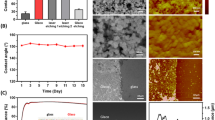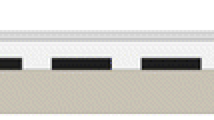Abstract
Fabrication of surfaces with heterogeneous contact angle hysteresis enables extraction of droplet samples from bulk liquid volumes. These surfaces are created by printing high hysteresis wax islands onto low hysteresis superhydrophobic paper. The volume of the sampled droplets depends on the hysteresis of the printed islands, which can be controlled through both physical and chemical means. Physically, hysteresis is modified through the addition of surface roughness. Chemical hysteresis is tuned by changing the active chemical groups present on the wax surface. The observed control of the volume of sampled droplets, which is necessary for quantitative biochemical or chemical assays, extends to scenarios in which multiple droplet samples are extracted simultaneously from a single bulk droplet. Demonstration of the capacity of this technique to perform colorimetric glucose immunoassays is described. The ability to obtain well-defined microliter sample volumes and to extract several samples simultaneously from the same source enables the development of two-dimensional paper-based microfluidic devices for biomedical testing.














Similar content being viewed by others
References
Callies M, Quere D (2005) On water repellency. Soft Matter 1(1):55–61. doi:10.1039/b501657f
Mertaniemi H, Jokinen V, Sainiemi L, Franssila S, Marmur A, Ikkala O, Ras RHA (2011) Superhydrophobic tracks for low-friction, guided transport of water droplets. Adv Mater 23:2911–2914
Li XM, Reinhoudt D, Crego-Calama M (2007) What do we need for a superhydrophobic surface? A review on the recent progress in the preparation of superhydrophobic surfaces. Chem Soc Rev 36(8):1350–1368. doi:10.1039/b602486f
Quere D (2008) Wetting and roughness. Ann Rev Mater Res 38:71–99. doi:10.1146/annurev.matsci.38.060407.132434
Xia F, Jiang L (2008) Bio-inspired, smart, multiscale interfacial materials. Adv Mater 20(15):2842–2858. doi:10.1002/adma.200800836
Roach P, Shirtcliffe NJ, Newton MI (2008) Progess in superhydrophobic surface development. Soft Matter 4(2):224–240. doi:10.1039/b712575p
Carré A, Mittal KLE (2009) Superhydrophobic surfaces. VSP/Brill, Leiden
Barthlott W, Neinhuis C (1997) Purity of the sacred lotus, or escape from contamination in biological surfaces. Planta 202(1):1–8
Cheng YT, Rodak DE (2005) Is the lotus leaf superhydrophobic? Appl Phys Letters 86(14):144101. doi:10.1063/1.1895487
Jiang L, Zhao Y, Zhai J (2004) A lotus-leaf-like superhydrophobic surface: a porous microsphere/nanofiber composite film prepared by electrohydrodynamics. Angew Chem Int Edit 43(33):4338–4341. doi:10.1002/anie.200460333
Sun TL, Feng L, Gao XF, Jiang L (2005) Bioinspired surfaces with special wettability. Acc Chem Res 38(8):644–652. doi:10.1021/ar040224c
Feng L, Zhang Y, Xi J, Zhu Y, Wang N, Xia F, Jiang L (2008) Petal effect: a superhydrophobic state with high adhesive force. Langmuir 24(8):4114–4119. doi:10.1021/la703821h
Furstner R, Barthlott W, Neinhuis C, Walzel P (2005) Wetting and self-cleaning properties of artificial superhydrophobic surfaces. Langmuir 21(3):956–961. doi:10.1021/la0401011
McHale G, Shirtcliffe NJ, Newton MI (2004) Contact-angle hysteresis on super-hydrophobic surfaces. Langmuir 20(23):10146–10149. doi:10.1021/la0486584
Xiu Y, Zhu L, Hess DW, Wong CP (2007) Hierarchical silicon etched structures for controlled hydrophobicity/superhydrophobicity. Nano Lett 7(11):3388–3393. doi:10.1021/nl0717457
Safaee A, Sarkar DK, Farzaneh M (2008) Superhydrophobic properties of silver-coated films on copper surface by galvanic exchange reaction. Appl Surface Sci 254(8):2493–2498. doi:10.1016/j.apsusc.2007.09.073
Qian BT, Shen ZQ (2005) Fabrication of superhydrophobic surfaces by dislocation-selective chemical etching on aluminum, copper, and zinc substrates. Langmuir 21(20):9007–9009. doi:10.1021/la051308c
Shiu JY, Kuo CW, Chen PL, Mou CY (2004) Fabrication of tunable superhydrophobic surfaces by nanosphere lithography. Chem Mater 16(4):561–564. doi:10.1021/cm034696h
Morra M, Occhiello E, Garbassi F (1989) Contact-angle hysteresis in oxygen plasma treated poly(tetrafluoroethylene). Langmuir 5(3):872–876. doi:10.1021/la00087a050
Balu B, Breedveld V, Hess DW (2008) Fabrication of “roll-off” and “sticky” superhydrophobic cellulose surfaces via plasma processing. Langmuir 24(9):4785–4790. doi:10.1021/la703766c
Balu B, Kim JS, Breedveld V, Hess DW (2009) Tunability of the adhesion of water drops on a superhydrophobic paper surface via selective plasma etching. J Adhesion Sci Technol 23(2):361–380. doi:10.1163/156856108x383547
Israelachvili JN (2010) Intermolecular and surface forces, 3rd edn. Elsevier, Amsterdam
Chen YL, Helm CA, Israelachvili JN (1991) Molecular mechanisms associated with adhesion and contact-angle hysteresis of monolayer surface. J Phys Chem 95(26):10736–10747. doi:10.1021/j100179a041
Barona D, Amirfazli A (2011) Producing a superhydrophobic paper and altering its repellency through ink-jet printing. Lab on a Chip 11(5):936–940. doi:10.1039/c0lc00335b
Wang CF, Wang TF, Liao CS, Kuo SW, Lin HC (2011) Using pencil drawing to pattern robust superhydrophobic surfaces to control the mobility of water droplets. J Phys Chem 115(33):16495–16500. doi:10.1021/jp204169p
Leopoldes J, Dupuis A, Bucknall DG, Yeomans JM (2003) Jetting micron-scale droplets onto chemically heterogeneous surfaces. Langmuir 19(23):9818–9822. doi:10.1021/la0353069
Balu B, Berry AD, Hess DW, Breedveld V (2009) Patterning of superhydrophobic paper to control the mobility of micro-liter drops for two-dimensional lab-on-paper applications. Lab on a Chip 9(21):3066–3075. doi:10.1039/b909868b
Balu B, Berry AD, Patel KT, Breedveld V, Hess DW (2011) Directional mobility and adhesion of water drops on patterned superhydrophobic surfaces. J Adhesion Sci Technol 25(6–7):627–642. doi:10.1163/016942410x525849
Sokoll LJ, Chan DW (1999) Clinical analyzers. Immunoassays. Anal Chem 71(12):356R–362R
Ferris SW, Cowles JHC, Henderson LM (1929) Composition of paraffin wax. Ind Eng Chem 21(11):3
Vandenburg LE, Wilder EA (1970) The structural constituents of carnauba wax. J Amer Oil Chemists’ Soc 47(12):514
Dettre RH, Johnson RE Jr (1964) Contact angle hysteresis. Am Chem Soc 43(43):136–144. doi:10.1021/ba-1964-0043.ch008
Bhushan B, Nosonovsky M, Jung YC (2007) Towards optimization of patterned superhydrophobic surfaces. J Royal Soc Interface 4(15):643–648. doi:10.1098/rsif.2006.0211
Martinez AW, Phillips ST, Butte MJ, Whitesides GM (2007) Patterned paper as a platform for inexpensive, low-volume, portable bioassays. Angew Chem Int Edit 46(8):1318–1320. doi:10.1002/anie.200603817
Martinez AW, Phillips ST, Whitesides GM (2008) Three-dimensional microfluidic devices fabricated in layered paper and tape. Proc Natl Acad Sci USA 105(50):19606–19611. doi:10.1073/pnas.0810903105
King EJ, Garner RJ (1947) The colorimetric determination of glucose. J Clin Pathol 1(1):30–33. doi:10.1136/jcp.1.1.30
Acknowledgments
The authors thank Dr. Ashwini Sinha (Praxair) for generously donating the pentafluoroethane (PFE) gas, Stephanie Didas for materials support and Yan Liu for support with CA measurements. The authors are also grateful to the Institute for Paper Science and Technology (IPST) at Georgia Tech for fellowship support for L.L.
Author information
Authors and Affiliations
Corresponding author
Additional information
This article is part of the Topical Collection on Contact Angle Hysteresis
Rights and permissions
About this article
Cite this article
Li, L., Breedveld, V. & Hess, D.W. Hysteresis controlled water droplet splitting on superhydrophobic paper. Colloid Polym Sci 291, 417–426 (2013). https://doi.org/10.1007/s00396-012-2755-2
Received:
Accepted:
Published:
Issue Date:
DOI: https://doi.org/10.1007/s00396-012-2755-2




